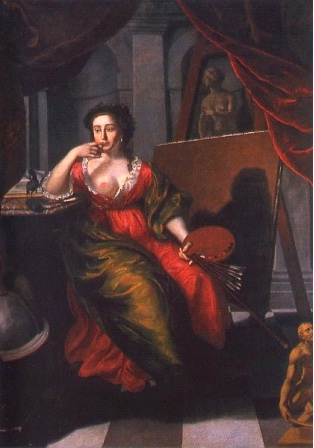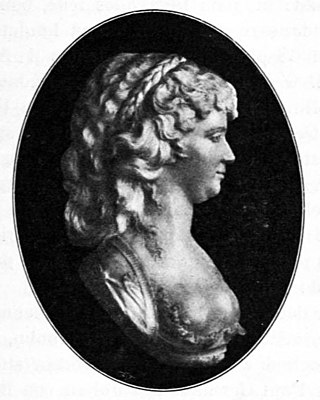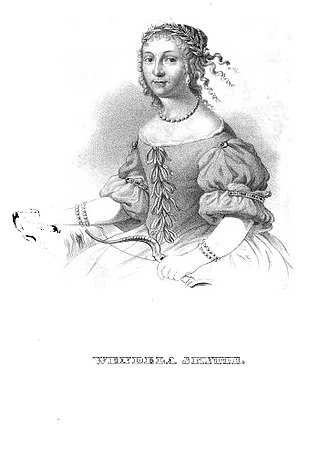Related Research Articles
Cecilia Månsdotter Eka also called Cecilia of Eka, was a Swedish noblewoman. She was the spouse of Erik Johansson Vasa and mother of King Gustav I of Sweden.

Hedvig Charlotta Nordenflycht was a Swedish poet, feminist and salon hostess.

Gunilla Bielke; Swedish: Gunilla Johansdotter Bielke af Åkerö was Queen of Sweden as the second wife of King John III. Queen Gunilla is acknowledged to have acted as the political adviser to John III and to have influenced his religious policies in favor of Protestantism.

Anna Maria Ehrenstrahl, was a Swedish Baroque painter. She is known for her allegorical works paintings, portraits and group portraits.

Sofia Franziska Stading was a Swedish opera singer of German origin. She is referred to as one of the more notable opera singers in Sweden during the Gustavian era. She was a Hovsångare and member of the Royal Swedish Academy of Music from 1788.
Mette Iversdotter Dyre was a Danish noble, nominal sheriff and chancellor. She was married three times to powerful men: two royal councillors and finally Svante, Regent of Sweden. As such she was a de facto queen consort. Mette Dyre is credited with political influence on the affairs of state through her spouse.

Helga de la Brache, née Aurora Florentina Magnusson,, was a Swedish con artist. She obtained a royal pension by convincing the authorities that she was the secret legitimate daughter of King Gustav IV of Sweden and Queen Frederica of Baden.
Henrika Juliana Lieven, Swedish, archaic; von Liewen was a Swedish noble, socialite and lady-in-waiting, politically active on behalf of the Hats (party) during the Age of liberty.

Vendela Skytte was a Swedish noblewoman, salonist and writer, poet and Lady of Letters. During her lifetime, she became an ideal and role model for a learned female scholar.
Anna Eriksdotter Bielke was a Swedish noble, commander of the city and castle of Kalmar during the Swedish rebellion against Denmark.

Sophie Margareta von Knorring, née Zelow, was a Swedish novelist and noble. She is regarded as a pioneer of the realistic novel in Sweden. Most of her novels are romantic love stories in an aristocratic environment.

Märta Helena Reenstierna, known as Årstafrun, was a Swedish diary writer. Her diaries were written in the period 1793–1839, and are kept at the archives of Nordiska museet in Stockholm. They were published in 1946–1953 as Årstadagboken. They are considered as a valuable cultural historical document of the everyday life of the people at a Swedish manor of her epoch.
Gunilla Johansdotter Bese, also called Gunhild (1475–1553) was a Finnish (Swedish) noble and fiefholder of Vyborg Castle from 1511 to 1513.
Blessed Ingrid of Skänninge was a Swedish abbess venerated as a saint in the Roman Catholic Church. She founded Skänninge Abbey, a nunnery belonging to the Dominicans, in 1272. Her feast day is on September 2.
Count Fabian Reinhold von Fersen was a Swedish count, politician, officer and courtier. He was the son of Axel von Fersen the Elder and Hedvig Catharina De la Gardie and the brother of Count Axel von Fersen the Younger, Hedvig Eleonora von Fersen and Sophie Piper.
Ebba Bielke (1570–1618), was a Swedish baroness convicted of high treason.
Events from the year 1528 in Sweden
Margareta Brahe was a Swedish courtier; hovmästarinna to princess Anna Vasa of Sweden, from 1591.
Anna Klemetsdotter Hogenskild (1513-1590), also known as fru Anna till Åkerö and fru Anna till Hedensö, was a Swedish court official and landowner. She served as hovmästarinna to queen Catherine Stenbock of Sweden, and then to the daughter and sisters of Eric XIV of Sweden.
Gustaf Brahe was a Swedish riksråd and a Polish Field marshal.
References
- ↑ Barbro Stigsdotter, urn:sbl:19056, Svenskt biografiskt lexikon (art av S. Samuelsson.), hämtad 2014-12-28.
- ↑ Barbro Stigsdotter, urn:sbl:19056, Svenskt biografiskt lexikon (art av S. Samuelsson.), hämtad 2014-12-28.
- ↑ Barbro Stigsdotter, urn:sbl:19056, Svenskt biografiskt lexikon (art av S. Samuelsson.), hämtad 2014-12-28.
- ↑ Barbro Stigsdotter, urn:sbl:19056, Svenskt biografiskt lexikon (art av S. Samuelsson.), hämtad 2014-12-28.
- ↑ A.L. Stjerneld (anonym), Gripsholmgalleriet (Stockholm 1833)